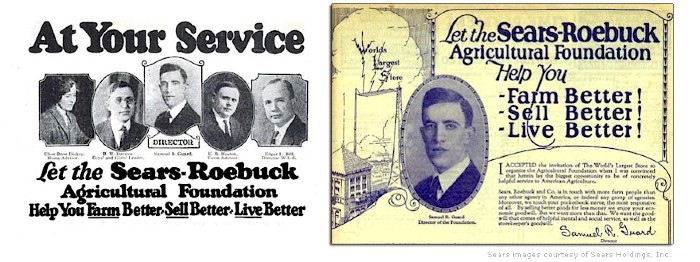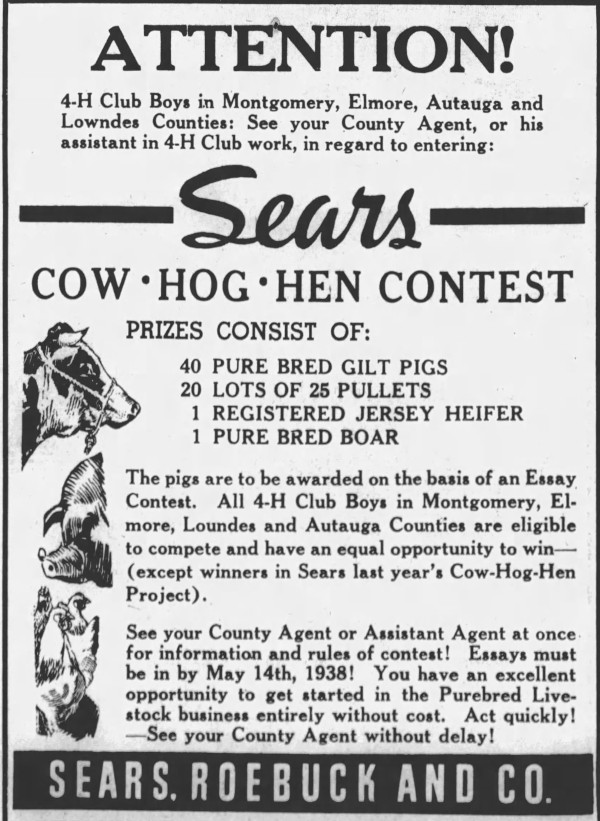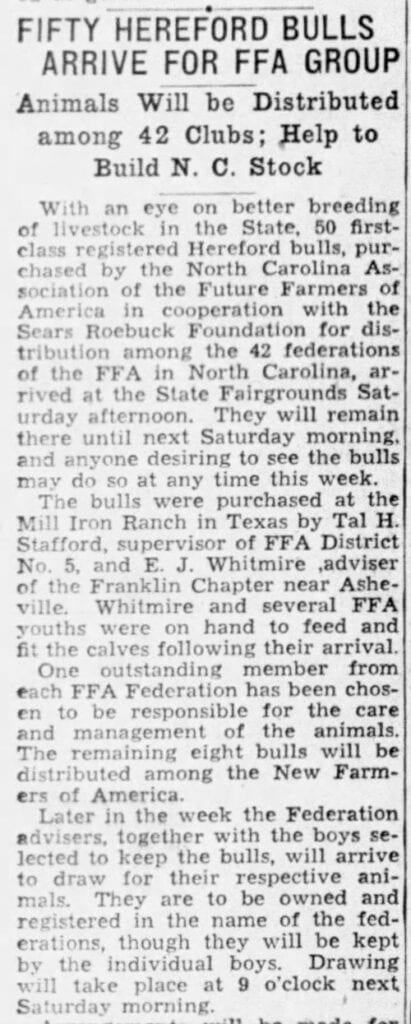In last week’s Footnote, we learned how farmers relied on Sears and Roebuck for many of their farm needs. While Sears served the needs of the farmers, they also made money from that relationship. In this Footnote, we will examine the philanthropic side of Sears and learn of their activities that specifically benefited agricultural and extension education.
But first an announcement! This is the last Friday Footnote until August 6. Some of you have heard me speak at state and national NAAE meetings about the importance of balancing work and family. The goal is to live your life so there will be no regrets. I believe in practicing what I advocate. By the time you read this, I will be in the state of Washington spending time with my daughter and her family. Then later in July I will be speaking at the Fountain Park Chautauqua in Indiana and am going to add a week on to that trip to explore the sights and culinary arts of the Midwest. So basically, July is a vacation month. I would encourage you to take a few weeks from work to recharge your batteries. Connect with your family. Now, on with the Footnote.
Sears and the County Agent
An on-farm boll weevil control demonstration in Texas led to the hiring of the first county-based agricultural agent in America in 1906 -William Stallings. Soon other southern states and counties were wanting their own county farm demonstration agents. There was no money in the USDA budget for this, so the General Education Board (an organization started by John D. Rockefeller in 1902 to support higher education in general plus farming and schools in the south) stepped in and started paying the salaries of these agents (which were located in the southern states). The federal government added one dollar to their pay so they would officially be employees of the federal government and enjoy franking privileges (using the mail at no expense).
Julius Rosenwald, the person who bought out Roebuck’s share in Sears and Roebuck and served as vice-president, then president, of Sears, saw a need for county agricultural agents in the Midwest and in other states. In May of 1912 he announced that Sears & Roebuck would offer $1,000 to each county in the United States who would raise additional funding to employ (Emmet & Jeuck, 1950, p. 622) a “trained agricultural expert for that county.”
Even though Rosenwald had pledged a million dollars to hire county agents, company records show that $110,00 was actually spent. The 110 participating counties were in Illinois, Wisconsin, Iowa, Indiana, Ohio, and Michigan. In 1914 Congress passed the Smith-Lever Act which established the Cooperative Extension Service, thus curtailing the need for Sears to continue their county agent program. So, it would not be a stretch to say that Sears and Roebuck helped establish cooperative extension.
The Agricultural Foundation
In 1923 Sear and Roebuck created an Agricultural Foundation. Its goal was to help the farmer “farm better, sell better, and live better.” It pledged to provide (Emmet & Jeuck, 1950, p, 623) “aid to farmers, and cooperation with all recognized agencies, Governmental, semi-official and private, which will work to that end.” Vocational agriculture and extension benefited greatly from Sears Agricultural Foundation.

Figure 1. Advertisements about the Sears-Roebuck Agricultural Foundation
A division was created in the Foundation called the Farm Services Division with the goal of serving individual farm families. If you had a question, consultants would answer it by mail. Advice was given on such topics as curing a cow of milk fever, how to destroy bugs that were destroying your beans, how to safeguard a child with rickets, and matching colors for a hat. Rosenwald believed the Farm Services Division functioned as a “mail-order county agent.”
One of the activities of the Agricultural Foundation was to produce movies for rural audiences on such topics as farm safety and care of livestock. The Foundation took Paul Chapman’s book The Greenhand and made it into a popular movie. The movie was about how FFA can transform young people for the better (for more detail see the October 5, 2018 Friday Footnote). The Foundation also converted John F. Case’s book Under the 4-H Flag into a movie about the power and value of 4-H. The FFA film “That Inspiring Task” was also produced by Sears.
The name of the Sears-Roebuck Agricultural Foundation was changed in 1941 to the Sears-Roebuck Foundation (Hurford, 1962). This name change indicated a broader mission, but agriculture was still an important component. The amended mission included these words (Hurford, 1962, p. 48):
…to grant scholarships and funds to enable persons to study at schools and colleges, to promote and improve agriculture and the breeding of better livestock and poultry, to conduct and supervise contests and educational activities relating to home improvement, the farm and the community…
Sears Agricultural Scholarship Program
In 1926 J. C. Haynes, was employed by Sears and Roebuck to be in charge of public relations in the southern states When Haynes was hired, he was told by company officials he would get whatever money he needed. He was given a substantial sum of money to invest in projects. Unsure of where to start, he visited Paul Chapman, Dean of Agriculture at the University of Georgia. Haynes started the conversation (Hancock, 2008, p. 61):
“I said I’ve got some money and I don’t know what to do with it. I said we want to do something real for the farm people. Paul Chapman looked up and said young man you are the answer to my prayer. I said what. He had a stack of letters a foot high on his desk of country boys who wanted to go to agricultural college but the University didn’t have the money. He said you can help some of these boys come here. I said I am not talking about that, you are talking about a whole lot of money. He said $100 will bring any of these boys to college and I’ll give them a job. I said pick out 20 you would rather have right quick and he said you mean it? I said yes. He shuffled through the letters and he picked 10 or 20 and I said tell them to come on. That will be the Sears Roebuck Foundation scholarship program. And we did it. And then I went to Florida and then to Tennessee and we started in four states.
From that beginning of the Sears Agricultural Scholarship Program in the South, it spread across the nation. By the end of 1941, the agricultural scholarship program had spread to all 48 states, Alaska and Puerto Rico with 1,132 scholarship recipients that year. By 1948 over 7,400 agricultural scholarships had been awarded. A survey of scholarship recipients revealed (Emmert & Jeuck, 1950, p. 632) “Many had become extension service workers, many were teaching vocational agriculture, and others were farming.” Recipients of Sears Agricultural Scholarship at North Carolina State University in 1949-50 are shown in Figure 2.

Figure 2. Sears Agricultural Scholarship recipients at North Carolina State University in 1949-50. Photo from the NCSU Library Special Collections.
Cow-Hog-Hen Program
What we know as livestock chains (See the May 3, 2019 Friday Footnote) was started by Sears as the “Cow-Hog-Hen” program. This started in four Georgia counties where an essay contest was sponsored in rural schools on “the advantages of the Cow-Hog-Hen plan of farming.” The Cow-Hog-Hen phrase was not new; the phrase had been used in Georgia starting in the early 1920s to encourage the farmers to diversify their farms. In other words, they should plant more than just cotton. Farmer should plant other crops in addition to cotton and add livestock. Sears borrowed that phrase and concept.
The thirty-two winning entries were awarded a purebred, registered gilt pig to be bred with a registered boar provided by the company. One female pig from each litter was to be returned to the local county agent to be redistributed the following year. At the end of the year, the thirty-two original winners were judged on how well they had cared for their pigs and the winners from this second competition were given 150 baby chicks and a purebred dairy heifer that would eventually fund similar poultry and bovine projects (Hancock, 2008).
The program started out with 4-H club members and later expanded to FFA members. The exact details of the program varied from county to county and from one state to the next. The program spread like wildfire. Often the contest winners were recognized at a banquet or at a special event at the Sears Farm Stores. Thousands and thousands of young people across the country benefitted from this program as did their parents. In 1941 Sears estimated that it had distributed 692 cows, 2.6 million hogs, and 13.7 million chickens. However, the program continued long after 1941.

Figure 3. Advertisement from May 8, 1938 Montgomery (AL) Advertiser.
The Bull Program
In 1946 Sears came to the conclusion that the fastest way to improve cattle was through the use of quality bulls. They selected the FFA to be the vehicle for their bull program. Sears contacted state directors of agricultural education and agriculture teachers in high schools to implement the bull program. Local FFA chapters were given quality bulls. The FFA members cared for the bulls and made them available to local farmers to service their cows.
The program started in North Carolina with 50 purebred yearling Hereford bulls from a ranch in Texas. Each of the 42 FFA Federations in North Carolina received a bull and the other 8 bulls were given to the New Farmers of America. The program then expanded to South Carolina and Georgia, and then to additional states. Over five hundred purebred registered Hereford bulls were given to FFA chapters by the Sears-Roebuck Foundation between 1946 and 1952. By 1952 almost 30,000 calves have been sired by bulls awarded by the Foundation. They were valued at almost $4,500,000.

Figure 4. Newspaper article from the Raleigh (NC) News and Observer, November 11, 1946.
Sears Adult Farmer’s Short Course
With the cooperation of the agricultural colleges, Sears established short courses (4-5 weeks in length) for adult farmers. The extension service picked one farmer per county to attend the course. Potential community leadership was one of the criteria used for selection. Sears paid all the expenses for the farmer-students. The curriculum included subjects such as farm business problems, animal husbandry, agronomy, agricultural engineering, and the like. The first state to start the program was Alabama followed by Georgia, North Dakota, Kansas, and Minnesota and it spread from there.
WLS Radio Station
In 1924 Sears established the Chicago radio station WLS (World’s Largest Store). The station broadcast farm and weather reports. It provided entertainment for the farm family but also had farming-related programming and advice for the farmer. This station could be heard throughout the Midwest. The station did not have any advertising because whatever was advertised in all probability would be in competition with Sears. Since there was no advertising revenue, it did not return a profit. It was sold in 1928 to the Prairie Farmer Newspaper which made its Barn Dance program a national hit.

Figure 5. Advertisement for the WLS Radio Station
In order to reach farmers in the south, Sears purchased substantial airtime on Atlanta radio station WSB and produced much of the programming that was aired. The programing consisted of entertainment and education. One such program was “Dinner Bell R.F.D.” that was broadcast between noon and 1 PM. It featured old-time musicians and string bands and also provided valuable farm advice sent in by the listeners (Hancock, 2008).
Contest and Shows
After investigating poor corn yields, the Sears Agricultural Foundation concluded inferior seed corn was part of the problem. In 1925 Sears conducted a national seed corn show (by mail). The best ear of corn from the 27,411 entries received a $1,000 prize. Runner-up entries received lesser prizes. Each ear of corn submitted was tested for vitality and disease and the results were sent to each grower. The data on the ears of corn were aggregated by county and state and made public.
In 1928 another contest was conducted, but it was for cotton. Farmers submitted a single stalk of cotton. There were over 20,000 entries competing for $10,000 in prize money.
In 1929 Sears sponsored a canning contest. There were 43,000 entries from the farm women. A plethora of other contests followed:
- 1930 – 4-H Club scenario-writing with 2,000 entries (these entries provided ideas for the Foundation’s film making endeavors)
- 1930 – A “Home Beautiful” contest with 150,000 entries
- 1933 – A quilting contest with 17,000 entries
- 1933 – National baby contest with 102,000 entries
- 1935 – “Make it Yourself” clothing competition with 46,000 entries
In 1948 Sears partnered with the national Grange to start Community Improvement contests.
Victory Garden Program
At the outset of World War II the Sears, Roebuck Foundation partnered with the National Committee on 4-H Clubs for the War Food Production Program. Cash and war bonds were offered as prizes. The program was responsible for the creation of 1,578,359 gardens. These were not regular farm gardens renamed victory gardens. Under the terms of the agreement, these were totally separate plots totaling 1,130,000 acres. War Food Administrator Marvin Jones said that the Sears, Roebuck victory-garden program was the outstanding organized effort in the whole war food production program (Emmert & Jeuck, 1950).
Raw Fur and Wool Program
While not wholly educational, the Sears Raw Fur and Wool programs helped rural America. The two programs deserve a brief mention here. Early on Sears had established a reputation as being fair and honest. In 1925 Sears had received a large number of complaints from trappers that their local fur buyers were cheating them and could Sears do something to help them. So, Sears started a Raw Fur Marketing Service. Trappers sent their furs to Sears who had the furs graded and marketed at the best possible price.
Sears started producing a booklet Tips for Trappers (written by Johnny Muskrat). The booklet was educational in nature and described and showed the right and wrong ways of trapping practices. Over 7 million copies of the booklet were distributed.
To further educate trappers, Sears started (in 1929) staging a National Fur Show. This became an annual event and large cash prizes were given to the trappers who exhibited the award-winning pelts. By June of 1948 Sears had handled 4 million fur shipments from all 48 states and paid out 45 million dollars to the trappers.
The success of the fur program led to the establishment of a similar program for wool. During the first sixteen years of the wool program Sears handled 50,000 shipments of wool weighing 13 million pounds and paid out 3 million dollars (Emmet & Jeuck, 1950).
Concluding Remarks
Over the decades Sears, Roebuck and Company supported the 4-H, FFA, and the NFA in innumerable ways. It would be next to impossible to measure the impact they had on agricultural and extension education or the contributions they made to improving agriculture in America. In addition to the activities mentioned in this Footnote, Sears provided metal owls to FFA chapters and loaned the FFA a Sears Company airplane for the FFA Officers Goodwill tour. It is sad to see the decline of Sears in recent years.


Figure 6. Advisor’s Owl Presented to FFA Chapters by Sears and Roebuck. I can find no information about these owls. Photo courtesy of Andrew Smith.
In 1958 the American Vocational Association (now ACTE) at its annual meeting in Washington, D.C., presented to J. C. Worthy, the president of The Sears-Roebuck Foundation, a citation for meritorious service in the “support and development of vocational education in our nation.”(Hurford, 1962). Today we have many friends and supporters of our programs. We need to make a concerted effort to thank them and recognize them for their support while they are still around to hear the words.

Figure 7. It is important to recognize our supporters. J. C. Haynes, a Sears official received the Honorary American Farmer Degree in 1954. He also chaired the Georgia 4-H Advisory Committee. Numerous other Sears-Roebuck officials have been awarded honorary degrees by the FFA over the years. Photo from the Alabama Future Farmer, May 1955.
Have a great July. The Friday Footnote is not disappearing. It will return in August.
References
Emmet, B. & Jeuck, J (1950). Catalogues and Counters. The University of Chicago Press.
Hancock, Jr., Jerry R., (2008) Dixie Progress: Sears, Roebuck & Co. and How it became an Icon in Southern Culture. Thesis, Georgia State University, 2008. https://scholarworks.gsu.edu/history_theses/32
Hurford, David (1962). The Sears-Roebuck Foundation, A Business History of the Sears, Roebuck Public Relations Program, 1950-1960. Thesis. The University of Southern California.
